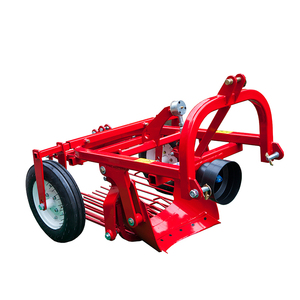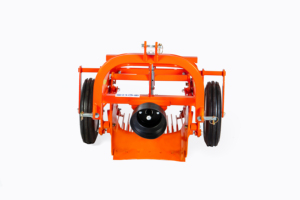
All categories
Featured selections
Trade Assurance
Buyer Central
Help Center
Get the app
Become a supplier

(1684 products available)



























There are many types of self-propelled maize combine harvesters, which can be divided into several categories according to the classification methods.
According to the mode of power transmission
The self-propelled maize combine harvester has two types: hydraulic drive and mechanical drive. They are different in that they drive the cutter bar and the rear discharge device through a variable-speed gearbox, which is connected by a belt. In comparison, the hydraulic drives use a system consisting of hydraulic motors and pumps.
According to the maize processing method
The self-propelled maize combine harvester can be divided into ear maize harvesters and grain maize harvesters. The former harvests maize ears and leaves the stalks in the field, while the latter harvests both maize ears and stalks.
According to the working width
Working width is an important parameter that distinguishes different types of self-propelled maize combine harvesters. Generally speaking, the larger the working width, the higher the harvesting efficiency.
According to machine size
The size of the machine can usually be classified into three types: large-sized self-propelled maize combine harvesters, middle-sized self-propelled maize combine harvesters, and small-sized self-propelled maize combine harvesters.
Self-propelled maize combine harvesters are some of the most advanced specifications found in the maize harvesting machine industry. They mostly vary according to the manufacturer. They typically come in specifications such as a cutting width of anywhere from 3 to 9 meters, a processing capacity of around 5 to 10 tons per hectare, and an engine power ranging from 150 to 500 horsepower.
Some of the self-propelled harvester's distinguishing features include the driver, which is usually spacious and includes air conditioning for use in extreme weather conditions. Moreover, they include advanced monitoring systems that can show fuel consumption and the remaining harvesting progress. They also have a variety of grain and crop types, such as maize, rice, wheat, and barley, to name a few. They sometimes even have integrated GPS technology and auto-steering functionalities that can ensure precise guidance and automation while optimizing harvesting efficiency and minimizing crop loss.
Self-propelled maize combine harvester maintenance is crucial for proper functioning and extending its lifetime. A daily inspection is important, including but not limited to checking fluid levels, belts, hoses, and filters. They should also look for signs of wear, damage, or leaks. Cleaning the machine thoroughly is important after harvest. This includes removing any crop residue, dirt, or debris from all surfaces, especially radiators, filters, and cooling systems. It's also important to avoid cross-contamination between fields and to dispose of waste appropriately. Following a strict cleaning regimen is crucial for maintaining combine harvester efficiency. This applies especially to self-propelled diesel combine harvesters. Operators must religiously follow the manufacturer's instructions and maintenance schedules that are advised for the machine. The combine harvester's performance and efficiency will be greatly improved if the engine oil and filter, air filter, fuel system, and harvesting components of the machine are cleaned or replaced at the recommended intervals. It's also important to use the recommended oils, fluids, and filters.
Finally, the combine harvester should be inspected by a trained professional at regular intervals to ensure that any potential or minor issues do not become larger and more dangerous over time.
Self propelled maize combine harvesters are modern agricultural machines used to harvest maize crops in large maize farms efficiently. They can navigate various terrain types independently without needing to be towed by another vehicle. Self-propelled maize combine harvesters can perform a series of separate agricultural processes, including reaping, threshing, cleaning, shelling, and packing the maize into bags or trucks. They have powerful diesel engines and usually large rubber tires or tracks to protect the maize field and avoid soil compaction.
Self-propelled maize combine harvesters are not just for maize but also harvest other cereals like wheat, barley, rice, and oats. They are also used in hilly and mountainous regions where conventional harvesters cannot easily navigate the terrain. Farmers in such areas make use of self-propelled harvesters with header leveling and quality straw management features that can harvest crops efficiently while minimizing straw burning and field pollution.
These machines are invaluable in large-scale maize production systems, especially where timely harvesting is essential to avoid losses due to lodging, diseases, or adverse weather conditions. Farmers in such areas prefer models with high-capacity threshers, separation systems, and grain-cleaning mechanisms to maximize efficiency and minimize grain loss.
Self-propelled combine harvesters have revolutionized maize farming by making it possible to harvest even 15 to 20 acres of land per hour, depending on the model. Combine harvesters are not just for maize but also harvest other cereals like wheat, barley, rice, and oats. In addition to saving time, they improve grain quality and reduce harvesting costs by about 75% compared to manual methods.
Large-scale farmers seeking to maximize productivity, minimize crop loss, and reduce labor costs during maize harvesting often rely solely on self-propelled maize combine harvesters. They have increased efficiency in agriculture by reducing the number of people needed to harvest maize and other cereal crops. Universities, governmental, and non-governmental agricultural research centers also use them to carry out on-farm trials to evaluate different crop management practices and their impact on yield and grain quality.
Here are some essential factors to consider when choosing the right self propelled maize combine harvester.
Maize field size and layout:
Understanding the dimensions of the maize fields is crucial. The self-propelled harvester chosen must have the capacity to efficiently harvest maize in fields of varying sizes. Additionally, the layout of the maize fields, including factors such as row spacing, obstacles, and terrain, must be considered to select a harvester that can manoeuvre effectively.
Harvesting requirements:
Consider the purchasing maize combine harvesters' various models and their specific harvesting requirements. Different combines may be suited for particular types of maize or farming practices. For instance, some combines are designed to handle high-density maize fields, while others may be more suitable for conventional maize varieties. Additionally, consider other factors such as the desired harvesting method (e.g., whole-ear harvesting or grain-only harvesting) and any specific quality requirements (e.g., minimizing ear breakage or preserving kernel integrity).
Budget and cost considerations:
These are key factors in determining the type of self-propelled maize combine harvester. Self-propelled maize combines generally have higher initial costs compared to pull-type or powered combines due to their self-propulsion system and larger capacity. Consider not only the initial purchase cost but also ongoing expenses such as maintenance, fuel consumption, and depreciation. Balancing the budget constraints with the need for an efficient and appropriate combine harvester is essential for sustainable maize farming operations.
Operator comfort and safety:
It's also important to consider the combine harvester's overall working environment. It includes factors such as cab design, visibility, controls, and climate control systems. A well-designed and ergonomic cab can reduce operator fatigue and enhance productivity during long harvesting days. In addition, consider the combine's safety features and ensure it has the necessary safeguards to protect the operator and maintenance personnel.
Maintenance and service support:
It is essential to consider the maize combine harvester selected needs to be maintained properly to ensure optimal performance and longevity. Therefore, the availability of maintenance and service support is crucial. When choosing a self-propelled maize combine harvester, it is important to research and select reputable brands that offer extensive service networks. Spare parts should also be readily available to minimize downtime in case of equipment failure. Service providers with knowledgeable technicians can assist with routine maintenance, repairs, and timely support when needed.
Q1: How fast can a combine harvester go when harvesting maize?
A1: The speed of a combine harvester depends on the model and type. Most modern maize harvesters, such as the self-propelled ones, have cruising speeds of between 10 to 30 km/h.
Q2: What type of fuel does a combine harvester use?
A2: Most combine harvesters use diesel fuel, just like large farming machinery and vehicles. Some old models may use combine harvester gasoline.
Q3: How many horsepower does a combine harvester have?
A3: The horsepower of a combine harvester ranges from 200 to 500. Some large self-propelled combine harvesters can have up to 600 horsepower.
Q4: How many self-propelled combine harvesters are sold each year in the world?
A4: The number of self-propelled combine harvesters sold each year is in the thousands. Around 1,300 self-propelled harvesters were sold in the United States in just one year.